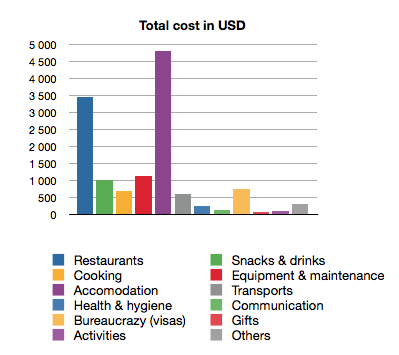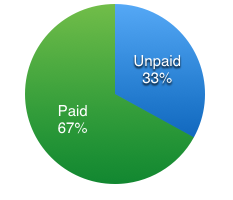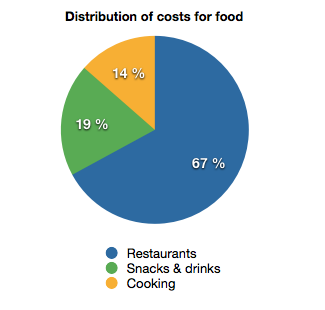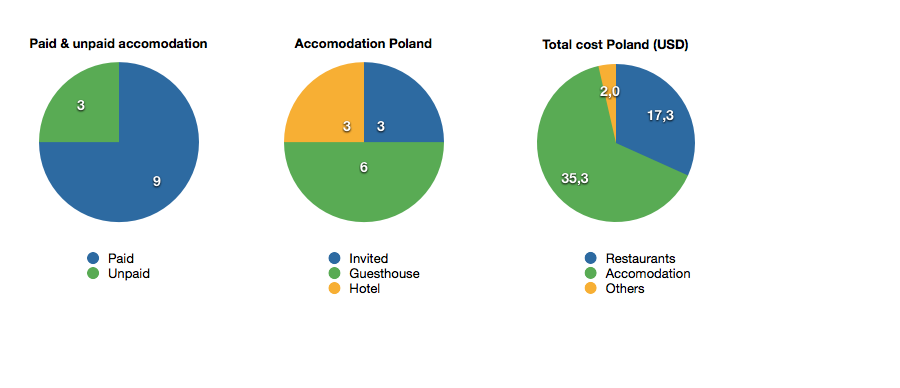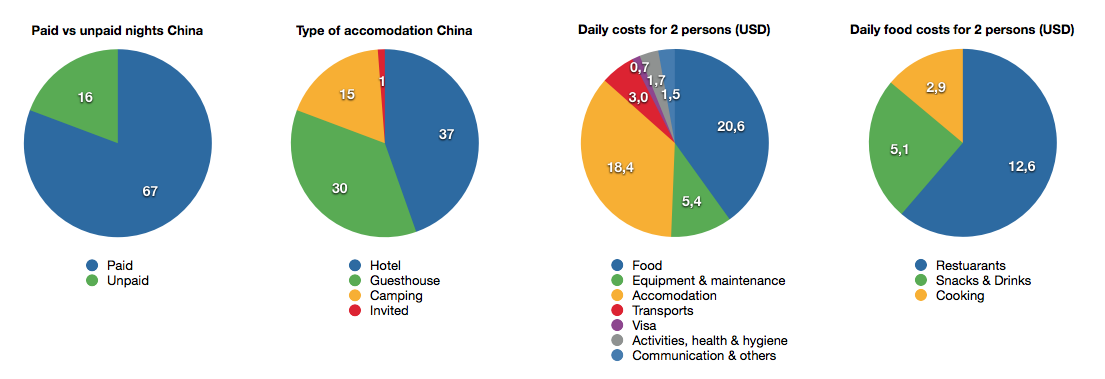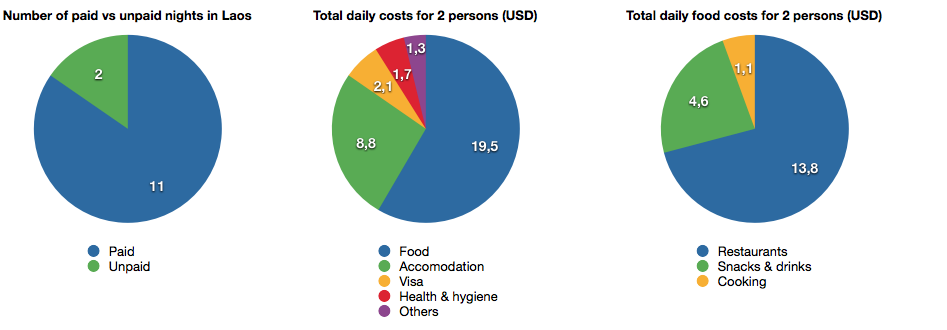One of the big questions before heading out on this journey was how big costs to expect. Various internet forums and other blogs suggested a budget frame of around 10-20 USD per day and person depending on country and type of accomodation. We had no clue if those figures were realistic or if we would be able to stick to such a budget. Out of curiosity we decided to note all our spendings in order to follow up on it afterwards.
We have now gone through all our notes and can conclude that our total spending is slightly below 12.500 USD. The trip lasted 280 days including restdays and that means we have spent 44.5 USD per day together or 22.2 USD each.
A return ticket from Göteborg to Bangkok usually costs around 8000 SEK or 1200 USD. Our total costs for the cycling trip was roughly the same as the price of 10 individual return flights to Bangkok. Or if you put it in another way – cycling here together cost us the same as flying here together 5 times. Guess what we think has given most bang for the buck…. 😉
The chart below shows how the total cost were split among our different “accounts”.
The purpose of this blog post is to try to give a picture of how our costs for the 9.5 month long journey were distributed and we do hope it will be of some help to other cyclists who are in the planning phase. Before digging deep into the figures for each country it is necessary to give some relevant background facts.
Wej and I are in our mid-forties, have no kids and have worked for a very long time. This means that we have been able to allow ourselves a rather generous budget, or to be correct – we didn’t really have a budget, we used some of our savings and our only concern was to not spend all of it…. 🙂
ACCOMODATION
As can be seen above accomodation and food have been our highest cost and thus need to be elaborated on. One important thing to note is the ratio between paid vs unpaid nights that didn’t really turn out like we had planned to. Why it turned out this way is discussed in the sections below.
Our expectations was to ride in sub-zero temperatures for maximum 3-4 weeks before the arrival of spring and then we hoped to enjoy warmer weather. We thus made the strategic decision to only bring a light tent and summer sleeping bags which meant that we had to stay at cheap hotels or guesthouses until night temperatures were above 3-4 degrees. Unfortunately the winter of 2013 in central Europe was extremely cold and we coulnd’t start camping until we reached Bulgaria.
We have done a few more longer stops than we had first planned. We stopped for about a week in Istanbul, Batumi, Tbilisi (due to injury), Osh, Chengdu (visa extension) and Kunming with 3-4 day stops in Baku, Sary Tash and Hami. During most of those stops we stayed either in hotels or hostels.
We don’t mind to stay in lousy guesthouses or camp behind a bush 10 meters beside the road, but since we haven’t had a too tight budget we have also sometimes allowed ourselves to opt for more expensive hotels with high standard rather than always going for the cheapest available option.
In Uzbekistan the rules requiring foreigners to register with the authorities by checking in at hotels forced us to stay more often at hotels and guesthouses than we actually would have preferred to.
FOOD
We are both very interested in local food culture which has meant that we have eaten more often at restaurants than what has been necessary. Of course we could have saved a lot of costs here, but to travel is to eat and we never wanted to cut back on trying interesting local cuisine.
We have noted all our costs for what we have consumed. In the early part of the trip we spent a lot of money on coffee at central european gas stations. After a month or so we understood that we should split prepared food that we buy in restaurants from snacks and drinks we buy along the road and stuff we buy in stores to cook by ourselves. This means that the pie chart below isn’t completely trustworthy and is a bit biased, but as anyone can see, there is a lot of money to save by not being too interested in local cuisine 😉
Take a look at the chart below showing the average daily spending in each country. We have cut out things such as when we bought new equipment for our camera in Bulgaria and the tickets to the ferry rides across the Baltic and the Caspian Seas. Our two home countries, Sweden and Thailand, were the cheapest but that is mainly due to the fact that we have so many wonderful friends in those countries. The very high average for Azerbaijan was due to a short stay and a high visa fee and lots of taxi rides across the city of Baku to collect other visas. If we would have had to wait for the ferry for a couple of more days the average daily spending in Azerbaijan would have dropped significantly.
COUNTRY BY COUNTRY
Below you will find a few charts for each country. They will show the ratio of paid vs. unpaid nights and the distribution between nights we have been invited to someone, camping, staying in hotels or guesthouses. Remember that the pie charts show the average cost for accomodation split on all nights in each country including nights when we have camped which brings down the average. As a service and clarification I will under the notes for each country also tell our average cost for each paid night.
There will also be a chart showing the distribution of the total cost and one how the cost for food was split in each country.
All costs that are shown are for two people. If you will travel on your own I think you can divide most of the figures by half to get a good approximation. When it comes to accomodation it will be harder since we can fill up a double room while a single traveler would have to pay for it by himself.
We have passed 15 countries using 15 different currencies so which one to use for these charts? As I see it, it could be either US dollars or Euro and I opted for US Dollars. In the notes for each country I will state the exchange rate we have used when calculating.
The piecharts are made in excel and I have uploaded a print screen of them. They are rather small as they appear on a screen, but click on them and you can see them in a larger size.
Sweden
- 1 USD = 6,7 SEK
- Our total costs for 12 days in the country was 240 USD (1600 SEK)
- Cost for ferry ticket across the Baltic Sea is not included in the daily average spending but it included in the total summary
Our two weeks in Sweden were a bit different to the rest of the trip. We visited friends along the way and didn’t spend anything on accomodation. Our only spendings were food along the way and some wine and food we brought to our hosts.
Poland
- 1 USD = 3 zloty
- Our total cost for the 12 days spent in Poland was 654 USD (2310 Zloty)
- Average cost for each paid night was 47 USD
- We never cooked ourselves
Slovakia
- 1 USD = 0,77 Euro
- Our total cost for two nights was 124 USD (95 €)
- The hotel room cost us 33 Euro and the Guesthouse was 30 Euro.
Slovakia was the smallest country we passed. It took two hours in one afternoon, one full day and then two more hours the third day before exiting to Hungary. We spent two nights in the country, one at a hotel and one at a backpackers guesthouse. One of the nights we treated ourselves to with a great dinner which drove up the average daily cost.
Hungary
- 1 USD = 220 Forint
- Our total cost for 4 nights in the country was 292 USD (64300 Forint)
- We never cooked ourselves
Hungary is also a small country which could have been passed in three days. Unfortunately we got stuck in a massive snowstorm and had to check in at an expensive hotel, then move to a cheaper B&B to wait for the roads to get cleared.
Romania
- 1 USD = 3,25 Lei
- Our total cost for two weeks in the country was 630 USD (2045 Lei)
- Average cost per paid night was 28,5 USD
- We never cooked ourselves
Bulgaria
- 1 USD = 1,52 Leva
- Our total costs for the 5 nights in the country was 192 USD (292 Leva)
- Average costs per paid night was 30,5 USD
In Bulgaria we finally started to camp and cook for ourselves.
Turkey
- 1 USD = 1,53 TL (Turkish Lira)
- Total costs for 5 weeks in Turkey was 1752 USD (2680 TL)
- Average cost per paid night was 46,1 USD
- Visas not required for Thai and Swedish citizens
We spent five nights at a rather expensive hotel in Istanbul which brought up the average cost for accomodation. When staying at small hotels or motels we usually paid around 40-80 TL. We also turned in our bikes for a thorough and expensive service and technical overhaul.
Georgia
- 1 USD = 1,79 GEL (Georgian Lari)
- Total cost for 24 days in the country was 944 USD (1690 GEL)
- Average cost per paid night was 18,5 USD.
- Visas not required for Thai and Swedish citizens
We stopped longer than planned in Batumi to apply for visa to Azerbaijan and arrange for our chinese visas. On the way between Batumi and Tbilisi Wej fell and hurt her knee which forced us to stay an extra week in Tbilisi to let it heal. All this meant that we spent a lot longer time in cities than we planned and thus got far less camping nights than expected.
Azerbaijan
- 1 USD = 0,81 Manat
- Total cost for our 10 days in the country was 781 USD (632 Manat)
- Average cost per paid night was 46,6 USD. Most of those nights were spent in Baku waiting for visas and the ferry.
- The visa fee was 168 USD for both of us together
- The cost for the ferry tickets across the Caspian Sea to Kazakhstan was 220 USD (110 each) but it is not included in the cost for transportation in pie chart 3 below.
Kazakhstan
- 1 USD = 149 TG (Tenge)
- Total cost for our 9 days in the country was 242 USD (22.700 Tenge)
- The visa fee was 90 USD for the two of us together
- Actual cost per night at one of the two nice hotels in Beyneu was 35 USD. There are cheaper options located close to the railway station, but after a week in the dusty and extremely hot desert we were desperate for AC and a proper shower.
Kazakhstan is an expensive country to visit and our greatest cost must have been water in the desert. It would have been interesting to see how much we spent on buying water but now that cost is included in the “cooking” part rather than snacks & drinks, which is mainly coke and tea at the occasional tea houses we visited.
Uzbekistan
- 1 USD = 2700 Som at black market rates. The official rate was about 1 USD = 2100 Som
- Total costs for our 27 days in the country was 1040 USD (2.808.000 Som)
- Average cost per paid night was 22,8 USD
- The visa fee was 150 USD for the two of us together
Uzbekistan has a weird rule that you have to register with the authorities every third night. This is done by checking in to a licensed hotel or guesthouse. Camping in Uzbekistan is easy and people are friendly and helpful so it wouldn’t have been a problem to camp most of the nights. However, we decided to play it safe and checked in at guesthouses more often than required. Needless to say, nobody checked our registration slips from the guesthouses when we exited the country.
Kyrgyzstan
- 1 USD = 50 Som
- Total costs for our 13 days in the country was 494 USD (24.700 Som)
- Average cost per paid night was 30,6 USD
- No visa required for Swedish citizens. We think Thai citizens can get a visa on arrival
When we arrived in Osh we had done 50% of the trip and we decided to stay a few extra days at a nice hotel (44 USD/night) to celebrate. When we arrived in Sary Tash we found out that the border to China was going to be closed for 4 consecutive days. We checked in at one of the simple homestays and paid 17 USD/night. All this meant that we camped far less than planned in this country which is actually ideal for camping since it is sparsely populated and it is easy to find flat areas and water.
China
- 1 USD = 6,08 Yuan
- Total costs for 85 days in the country was 4309 USD (26.200 CNY)
- Average cost per paid night was 23,1 USD
- Visa fee in Sweden was 179 USD and the extension in Leshan was 59 USD for us together.
Camping in China is easy so it should be possible to get a lot more unpaid nights than we had. We stopped for a week in Chengdu waiting for visa extension, one week in Kunming to wait for better weather and the arrival of my cousin and for 4 days in Hami to do maintenance and planning. Camping is not really an option when staying in big cities and those long stops added to the very low level of camping. Small hotels in the countryside is also very inexpensive and we just couldn’t bother to go pitch the tent when the price for a double room was just 40-50 CNY (7 USD).
After a while in China all the kilometers ridden from Sweden started to take its toll on our bikes and we needed to replace a lot of components as well as tires which can be seen in the third pie chart below.
Laos
- 1 USD = 7800 Kip
- Total costs for 2 weeks in Laos was 467 USD (3.412.000 Kip)
- Average cost per paid night was 11,1 USD
- Visa fee was 33 USD
We have been to Laos before but couldn’t remember the price level but we thought it would be cheap. Unfortunately we couldn’t be more wrong…. There were plenty of cheap guesthouses along the way, but to buy food at restaurants was unexpectedly expensive. First we thought we were ripped off, but after studying menues and talking to locals (thai and lao languages are very similar) we understood that those high prices were not only for tourists, but for the locals as well. However, most locals seemed to prefer to eat at home in the evenings rather than eating out – I do understand why….
Wej is Thai and since Thai citizens don’t need visas, the cost for visa in the piechart below only reflects the cost for one visa (all other costs are for the two of us).
Thailand
- 1 USD = 31,8 Baht
- Total costs for 2 weeks in Thailand was 272 USD (11.900 Baht)
- Average cost per paid night was 13,8 USD
- Visa fee was 31 USD for 60 days and 56 USD to extend for another 30 days.
When we are in Thailand we are on our home turf and have lots of friends everywhere. We have only stayed a few nights at hotels or guesthouses and that has only been for logistical reasons (to not arrive too early). We stayed with my former host family 65 km NW of Bangkok for a week before doing the final ride into Bangkok.
Thailand has good food everywhere and there is absolutely no need to cook on your own which can be seen on our costs for food. Since Wej is a citizen of Thailand the cost for visa below only reflects my visa cost. Our plan is to stay for a while after finishing this journey so I applied for a 60 day entry visa (1000 Baht) and recently extended it with another 30 (1800 Baht) which makes the total visa cost per day throughout the visa’s validity 31 Baht or roughly 1 USD.
Edit March 7, 2016.
If you have read this far, then you are probably very interested in the costs for cycle touring. I then recommend you to check out the cost breakdowns of the “wandering wheels”.
Edit August 4, 2016
Daves Travel pages has an interesting article about the costs of bicycle touring. The article is about the costs of a trip between Greece and England.

